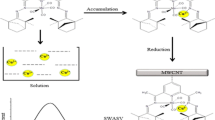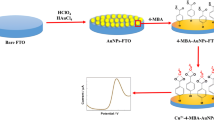Abstract
We performed explorative cyclic voltammetry in phosphate-buffered saline buffers, Dulbecco’s modified Eagle’s medium (DMEM), and fetal bovine serum-added DMEM using Au wire as working electrode, both in the absence and in the presence of known nominal concentrations of Cu2+ ions or 15 nm CuO nanoparticles. Addition of either Cu2+ ions or aqueous suspension of CuO nanoparticles caused a single anodic peak to appear in the double-layer region of all three pristine media. The height of the anodic peak was found to increase in a monotonic fashion vs. Cu2+ concentration in Cu2+-added media, and versus time since CuO addition in CuO-added media. Stepwise addition of glycine to Cu2+-added phosphate-buffered saline buffer caused an increasing cathodic shift of the anodic peak accompanied by decreasing peak currents. Results indicate that preparing Cu2+-free suspensions of CuO nanoparticles in such media is difficult, owing to the presence of leached copper ions. The implications on results of experiments in which CuO nanoparticle-added biological media are used as cell culture substrates are discussed. Literature data on the interactions between Cu2+ ions, dissolved carbon dioxide in aqueous CuO suspensions, and amino acids present in such media are compared to our results.


















Similar content being viewed by others
Reference
Altun Ö, Bilcen S (2010) Spectroscopic characterization of Cu(II) complexes of l-phenylalanine and d,l-tryptophan. Spectrochim Acta A 75(2):789–793
Arulsamy N, Rao CRK, Panthappally SZ (1991) Stereospecific reactions of copper(II) complexes of serine and threonine with formaldehyde. Transit Met Chem 16:606–609
Bard AJ, Faulkner LR (2001) Electrochemical methods—fundamentals and applications, chap. 6: potential sweep methods, 6.2 Nernstian (reversible) systems, 2nd edn. Wiley, New York, p 231
Barry PH, Lewis TM, Moorhouse AJ (2013) An optimized 3 M KCl salt-bridge technique used to measure and validate theoretical liquid junction potentials values in patch-clamping and electrophysiology. Eur Biophys J 42(8):631–646
Borgmann U, Ralph KM (1983) Complexation and toxicity of copper and the free metal bioassay technique. Water Res 17(11):1697–1703
Borsook H, Thimann KV (1932) The cupric complexes of glycine and of alanine. J Biol Chem 98(2):671–705
Burke LD, Nugent T (1997) The electrochemistry of gold: I the redox behaviour of the metal in aqueous media. Gold Bull 30(2):43–53
Conato C, Contino A, Maccarrone G, Magrì A, Remelli M, Tabbì G (2000) Copper(II) complexes with l-lysine and ornithine: is the side-chain involved in the coordination? A thermodynamic and spectroscopic study. Thermochim Acta 362:13–23
de Mele MFL, Salvarezza RC, Vasquez Moll VD, Videla HA, Arvia AJ (1986) Kinetics and mechanism of silver chloride electroformation during the localized electrodissolution of silver in solutions containing sodium chloride. J Electrochem Soc 133(4):746–752
DeLacey EHB, White LR (1981) Dielectric Response and Conductivity of Dilute Suspensions of Colloidal Particles. J Chem Soc Faraday Trans 2(77):2007–2039
Doğan A, Köseoğlu F, Kiliç E (2001) The stability constants of copper(II) complexes with some α-AMINO ACIDS in dioxan–water mixtures. Anal Biochem 295:237–239
Gale RJ, Winkler CA (1977) Thermal rearrangement of the copper(II)—L-cystine complex. Inorg Chim Acta 21:151–156
Garnier A, Tosi L (1975) Cu(II)–poly(l-arginine) complexes. Potentiometric and spectral characterization of amine and peptide nitrogen ligands. Biopolymers 14(11):2247–2262
Gaur JN, Schmid GM (1970) Electrochemical behavior of gold in acidic chloride solutions. J Electroanal Chem 24(2–3):279–286
Habbache N, Alane N, Djerad S, Tifouti L (2009) Leaching of copper oxide with different acid solutions. Chem Eng J 152:503–508. doi:10.1016/j.cej.2009.05.020
Käkinen A, Bondarenko O, Ivask A, Kahru A (2011) The effect of composition of different ecotoxicological tests media on free and bioavailable copper from CuSO4 and CuO nanoparticles: comparative evidence from a Cu-selective electrode and a Cu-biosensor. Sensors 11(11):10502–10521. doi:10.3390/s111110502
Karlsson HL, Cronholm P, Hedberg Y, Tornberg M, De Battice L, Svedhem S, Wallinder IO (2013) Cell membrane damage and protein interaction induced by copper containing nanoparticles—importance of the metal release process. Toxicology 313:59–69
Kizec R, Trnkova L, Ševčiková S, Šmarda J, František J (2002) Silver electrode as a sensor for the determination of zinc in cell cultivation Medium. Anal Biochem 301:8–13
Koch M, Kiefer S, Cavelius C, Kraegeloh A (2012) Use of a silver ion selective electrode to assess mechanisms responsible for biological effects of silver nanoparticles. J Nanopart Res 14:646–1051. doi:10.1007/s1-011-0646-y
Koper OB, Lagadic I, Volodin A, Klabunde KJ (1997) Alkaline-earth oxide nanoparticles obtained by aerogel methods. Characterization and rational for unexpectedly high surface chemical reactivities. Chem Mater 9:2468–2480
Liu A-C, Chen D, Lin C-C, Chou H-H, Chen C (1999) Application of cysteine monolayers for electrochemical determination of sub-ppb copper(II). Anal Chem 71:1549–1552
Liu G, Yu S, Liu S (2013) Enhanced electrocatalytic reduction of oxygen by repetitive square wave potential signal treated gold electrodes. Indian J Chem 52A:357–361
Malatesta F (2000) The impossibility of measuring individual ion activity coefficients using ion selective electrodes. J Solut Chem 29(9):771–779
Masuda H, Sugimori T, Odani A, Yamauchi O (1991) Structural evidence for the intramolecular charge-transfer interaction involving an indole ring in ternary copper(II) complexes with l-tryptophan and aromatic diamines. Inorg Chim Acta 180:73–79
Miao L, Wang C, Hou J, Wang P, Ao Y, Li Y, Lv B, Yang Y, You G, Xu Y (2015) Enhanced stability and dissolution of CuO nanoparticles by extracellular polymeric substancesin aqueous environment. J Nanopart Res 17:404. doi:10.1007/s11051-015-3208-x
Midander K, Cronholm P, Karlsson HL, Elihn K, Möller L, Leygraf C, Wallinder IO (2009) Surface characteristics, copper release and toxicity of nano- and micrometer-sized copper and copper(II) oxide particles: a cross-disciplinary study. Small 5(3):389–399. doi:10.1002/smll.2008012/20
Millero FJ, Santana-Casiano JM, González-Dávila M (2010) The formation of Cu(II) Complexes with carbonate and bicarbonate ions in NaClO4 solutions. J Solution Chem 39:543–558. doi:10.1007/s10953-010-9523-z
Neshkova MT, Kircova AA, Cattrall RW, Gregorio CG, Bond AM (1998) Flow injection discrimination of the chloride interference with Cu(II) electrode function of chalcogenide based solid-state copper ion-selective electrodes. Anal Chim Acta 362:221–234
Patra AK, Dhar S, Nethaji M, Chakravarty AR (2005) Metal-assisted red light-induced DNA cleavage by ternary Lmethionine copper(II) complexes of planar heterocyclic bases. Dalton Trans. doi:10.1039/B416711B
Patra AK, Roy S, Chakravarty AR (2009) Sinthesis, crystal structures, DNA binding and cleavage activity of l-glutamine copper(II) complexes of heterocyclic bases. Inorg Chim Acta 362:1591–1599
Ramakrishnan S, Rajendiran V, Palaniandavar M, Periasamy VS, Srinag BS, Krishnamurthy H, Akbarsha MA (2009) Induction of cell death by ternary copper(II) complexes of l-tyrosine and diimines: role of coligands on DNA binding and cleavage and anticancer acticity. Inorg Chem 48:1309–1322
Rand DAJ, Woods R (1972) A study of the dissolution of platinum, palladium rhodium and gold electrodes in 1 M sulphuric acid by cyclic voltammetry. J Electroanal Chem Surf Electrochem 35(1):209–218
Rao R, Patra AK, Chetana PR (2008) Synthesis, structure DNA binding and oxidative cleavage activity of ternary (Lleucine/isoleucine) copper(II) complexes of heterocyclic bases. Polyhedron 27(5):1343–1352
Schosseler PM, Wehrli B, Schweiger A (1997) Complexation of copper(II) with carbonate ligands in aqueous solution: a CW and pulsed EPR study. Inorg Chem 36:4490–4499
Sigel H, McCormick DB (1971) The structure of the copper(II)-l-histidine 1:2 complex in solution. J Am Chem Soc 93(8):2041–2044. doi:10.1021/ja00737a032
Tani Y, Soma M, Harsànyi EG, Umezawa Y (1999) Effect of dissolved oxygen on the response of Cu(II) ion-selective electrodes in metal buffer solutions. Anal Chim Acta 395:53–63
Valodkar VB, Tembe GL, Ravindranathan M, Ram RN, Rama HS (2004) Catalytic oxidation by polymer-supported copper(II)-l-valine complexes. J Mol Catal A: Chem 208:21–32
Viñes F, Gomes GRB, Illas F et al (2014) Understanding the reactivity of metallic nanoparticles: beyond the extended surface model for catalysis. Chem Soc Rev 43:4922
Wahl A, Dawson K, Sassiat N, Quinn AJ, O’Riordan A (2011) Nanomolar trace metal analysis of copper at gold microband arrays. J Phys 307:012061. doi:10.1088/1742-6596/307/1/012061
Weeks CM, Cooper A, Norton DA (1969) The crystal structure of the copper(II) complex of L-isoleucine. Acta Cryst B25:443–450
Acknowledgments
Funding from the Sustainable Nanotechnologies (SUN)—2013-2017—FP7-NMP-2013-LARGE-7-604305SUN Project is gratefully acknowledged. We also wish to thank Prof. Angelo Casagrande, Associated Professor, Department of Industrial Engineering, University of Bologna, for granting the use of the Autolab electrochemical workstation.
Author information
Authors and Affiliations
Corresponding author
Rights and permissions
About this article
Cite this article
Baldisserri, C., Costa, A.L. Electrochemical detection of copper ions leached from CuO nanoparticles in saline buffers and biological media using a gold wire working electrode. J Nanopart Res 18, 96 (2016). https://doi.org/10.1007/s11051-016-3403-4
Received:
Accepted:
Published:
DOI: https://doi.org/10.1007/s11051-016-3403-4




